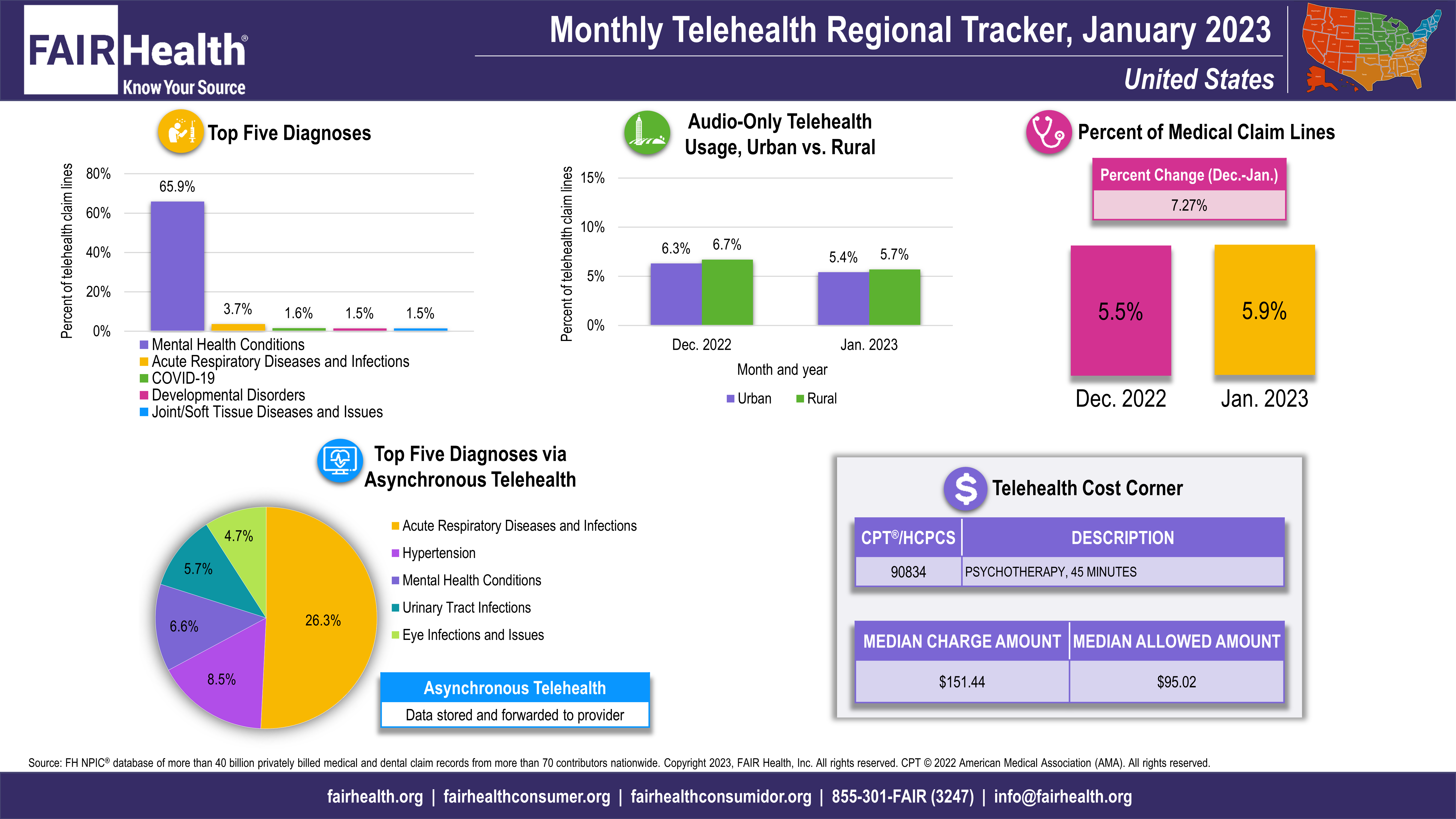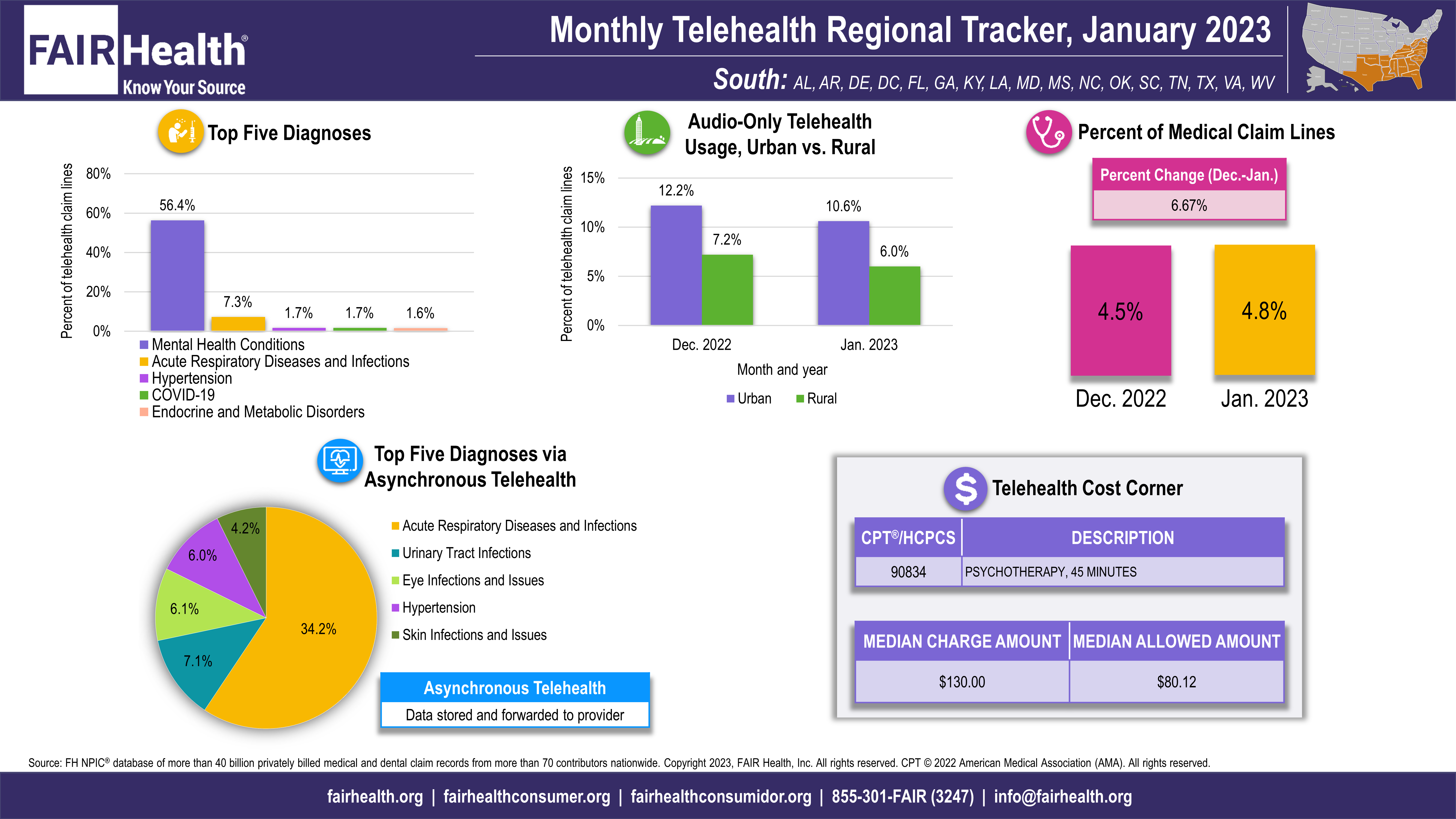- Center on Health Equity & Access
- Clinical
- Health Care Cost
- Health Care Delivery
- Insurance
- Policy
- Technology
- Value-Based Care
Contributor: Telehealth Utilization Grew 7% Nationally in January 2023
Utilization of telehealth increased by 7% nationally in the first month of 2023.
National telehealth utilization increased 7.3% in January 2023, from 5.5% of medical claim lines in December 2022 to 5.9% in January, according to FAIR Health’s Monthly Telehealth Regional Tracker (FIGURE 1).
It was the third straight month of growth in national telehealth utilization, a trend that began in November. In January, telehealth utilization also increased in all 4 US census regions—the Midwest (9.5%), the West (9.5%), the South (6.7%) and the Northeast (3.2%). The data represent the privately insured population, including Medicare Advantage and excluding Medicare fee-for-service and Medicaid.
Credit: FAIR Health

With January 2023, FAIR Health’s Monthly Telehealth Regional Tracker enters its fourth year of reporting on the evolution of telehealth from month to month. An interactive map of the US census regions allows the user to view an infographic on telehealth in a specific month in the nation as a whole or in individual regions.
This fourth year brings notable changes to the Telehealth Tracker. In the first year, to study the impact of the COVID-19 pandemic on telehealth, each month in 2020 was compared with the corresponding month in 2019. In the second year, the focus turned to monthly rather than year-over-year changes. The third year added new features, such as the Telehealth Cost Corner, which presents a specific telehealth procedure code with its median charge amount and median allowed amount. The Telehealth Cost Corner continues in the fourth year, as do the top 5 telehealth diagnoses and the percent change in telehealth’s percentage of medical claim lines. New features include audio-only telehealth usage (urban versus rural) and the top 5 diagnoses via asynchronous telehealth.
Audio-Only Telehealth Usage
From December 2022 to January 2023, audio-only telehealth utilization decreased nationally and in every region. The largest decrease occurred in the South, where audio-only telehealth utilization fell 16.6% in rural areas, from 7.2% of telehealth claim lines in December to 6.0% in January, while falling 12.8% in urban areas, from 12.2% of telehealth claim lines in December to 10.6% in January (FIGURE 2). Utilization of audio-only telehealth services was generally higher in rural than urban areas, except in the South, where it was higher in urban areas, and in January in the West, where rural and urban usage were approximately equal at 3.0% of telehealth claim lines.
Credit: FAIR Health

Asynchronous Telehealth
In January 2023, the number 1 diagnosis made via asynchronous telehealth—telehealth in which data are stored and forwarded (eg, blood pressure or other cardiac-related readings transmitted electronically; glycated hemoglobin [A1C] levels transmitted)—varied across regions. Nationally and in the South, it was acute respiratory diseases and infections. In the Northeast and Midwest, it was mental health conditions. In the West, it was encounter for screening.
Hypertension ranked second among the top 5 diagnoses via asynchronous telehealth nationally and in all regions except the South, where it ranked fourth.
Diagnoses
From December 2022 to January 2023, among the top 5 telehealth diagnoses nationally, developmental disorders and joint/soft tissue diseases and issues switched positions, with the former rising from fifth to fourth place and the latter falling from fourth to fifth place.
In January, COVID-19, which had ranked third among the top 5 telehealth diagnoses nationally and in every region in December, fell out of the top 5 in the Midwest and the West and dropped to fourth place in the South. COVID-19 remained in third place nationally and in the Northeast.
Costs
For January 2023, the Telehealth Cost Corner spotlighted the cost of CPT 90834, 45-minute psychotherapy. Nationally, the median charge amount for this service when rendered via telehealth was $151.44, and the median allowed amount was $95.02.
As the Monthly Telehealth Regional Tracker enters its fourth year, FAIR Health has again modified it to keep pace with the changing needs of stakeholders for current information about this venue of care. We look forward to another year of tracking the evolution of telehealth.
For the Monthly Telehealth Regional Tracker, click here.
